Development Characteristics of Natural Fractures in Metamorphic Basement Reservoirs and Their Impacts on Reservoir Performance: A Case Study from the Bozhong Depression, Bohai Sea Area, Eastern China
Abstract
:1. Introduction
2. Geological Setting
3. Dataset and Methodology
4. Results
4.1. Petrography
4.2. Characteristics of Natural Fractures by Image Logs
4.3. Characteristics of Natural Fractures by Cores
4.4. Characteristics of Natural Fractures by Thin Sections and SEM Images
5. Discussion
5.1. Factors Controlling Fracture Development
- (1)
- Lithotypes
- (2)
- Faulting
- (3)
- Weathering
5.2. Vertical Stratification of Reservoirs
5.3. Fracture Patterns in Metamorphic Rocks
5.4. Development Models of Reservoir Fracture Networks and the Role of Natural Fractures in Reservoirs
6. Conclusions
Author Contributions
Funding
Data Availability Statement
Acknowledgments
Conflicts of Interest
References
- Yu, Z.; Du, Y.; Xiao, K.; Wang, J.; Xiao, G.; Zhang, G.; Liang, Q.; Wang, Y. Characteristics and influence factors of basement buried-hill reservoir in Bongor Basin, Chad. Acta Petrol. Sin. 2019, 35, 1279–1290. [Google Scholar] [CrossRef]
- Jiao, X.; Niu, H.; Xie, Q.; Zattin, M.; Zhang, Y.; Wu, Z.; Chen, Y.; Zhao, X.; Liu, S.; Wei, X. Insights into the Weathering Crust Reservoirs of Granitoids: A Case Study from Qinghai Oilfield of Qaidam Basin, Northwest China. Minerals 2022, 13, 23. [Google Scholar] [CrossRef]
- Liu, G.; Zeng, L.; Han, C.; Mehdi Ostadhassan Lyu, W.; Wang, Q.; Zhu, J.; Hou, F. Natural Fractures in Carbonate Basement Reservoirs of the Jizhong Sub-Basin, Bohai Bay Basin, China: Key Aspects Favoring Oil Production. Energies 2020, 13, 4635. [Google Scholar] [CrossRef]
- Parnell, J.; Baba, M.; Bowden, S.; Muirhead, D. Subsurface biodegradation of crude oil in a fractured basement reservoir, Shropshire, UK. J. Geol. Soc. 2017, 174, 655–666. [Google Scholar] [CrossRef]
- Guo, Z.; Ma, Y.; Liu, W.; Wang, L.; Tian, J.; Zeng, X.; Ma, F. Main factors controlling the formation of basement hydrocarbon reservoirs in the Qaidam Basin, western China. J. Pet. Sci. Eng. 2017, 149, 244–255. [Google Scholar] [CrossRef]
- Lyu, Q.; Wang, W.; Jiang, Q.; Yang, H.; Deng, H.; Zhu, J.; Liu, Q.; Li, T. Basement Reservoirs in China: Distribution and Factors Controlling Hydrocarbon Accumulation. Minerals 2023, 13, 1052. [Google Scholar] [CrossRef]
- Marynowski, L.; Gawe¸da, A.; Poprawa, P.; Zywiecki, M.M.; Ke¸pińska, B.; Merta, H. Origin of organic matter from tectonic zones in the Western Tatra Mountains Crystalline Basement, Poland: An example of bitumen—Source rock correlation. Mar. Pet. Geol. 2006, 23, 261–279. [Google Scholar] [CrossRef]
- Ray, R.; Shukla, A.D.; Sheth, H.C.; Ray, J.S.; Duraiswami, R.A.; Vanderkluysen, L.; Rautela, C.S.; Mallik, J. Highly heterogeneous Precambrian basement under the central Deccan Traps, India: Direct evidence from xenoliths in dykes. Gondwana Res. 2008, 13, 375–385. [Google Scholar] [CrossRef]
- Zhang, X.; Yao, Y.; Zhang, G.; Ma, R.; Wang, Z. Natural fractures in a metamorphic buried hill reservoir, Bozhong 19–6 area, Bohai Bay Basin, China. Mar. Pet. Geol. 2023, 155, 106402. [Google Scholar] [CrossRef]
- McCaffrey, K.J.W.; Holdsworth, R.E.; Pless, J.; Franklin, B.S.G.; Hardman, K. Basement reservoir plumbing: Fracture aperture, length and topology analysis of the Lewisian Complex, NW Scotland. J. Geol. Soc. 2020, 177, 1281–1293. [Google Scholar] [CrossRef]
- Xu, C.; Yu, H.; Wang, J.; Liu, X. Formation conditions and accumulation characteristics of Bozhong 19-6 large condensate gas field in offshore Bohai Bay Basin. Pet. Explor. Dev. 2019, 46, 27–40. [Google Scholar] [CrossRef]
- Xue, Y.; Zhao, M.; Liu, X. Reservoir Characteristics and Controlling Factors of the Metamorphic Buried Hill of Bozhong Sag, Bohai Bay Basin. J. Earth Sci. 2021, 32, 919–926. [Google Scholar] [CrossRef]
- Olson, J.E.; Laubach, S.E.; Lander, R.H. Natural fracture characterization in tight gas sandstones: Integrating mechanics and diagenesis. AAPG Bull. 2009, 93, 1535–1549. [Google Scholar] [CrossRef]
- Feng, J.; Ren, Q.; Xu, K. Quantitative prediction of fracture distribution using geomechanical method within Kuqa Depression, Tarim Basin, NW China. J. Pet. Sci. Eng. 2018, 162, 22–34. [Google Scholar] [CrossRef]
- Li, H.; Yu, F.; Wang, M.; Wang, Y.; Liu, Y. Quantitative prediction of structural fractures in the Paleocene lower Wenchang formation reservoir of the Lufeng Depression. Adv. Geo-Energy Res. 2022, 6, 375–387. [Google Scholar] [CrossRef]
- Chen, J.; Wang, L.; Wang, C.; Yao, B.; Tian, Y.; Wu, Y.-S. Automatic fracture optimization for shale gas reservoirs based on gradient descent method and reservoir simulation. Adv. Geo-Energy Res. 2021, 5, 191–201. [Google Scholar] [CrossRef]
- Wang, D.; Li, L.; Zhang, H.; Li, S.; Zhang, F.; Xia, Y. Intelligent identification of coal fractures using an improved U-shaped network. Adv. Geo-Energy Res. 2025, 15, 129–141. [Google Scholar] [CrossRef]
- Liu, J.; Mei, L.; Ding, W.; Xu, K.; Yang, H.; Liu, Y. Asymmetric propagation mechanism of hydraulic fracture networks in continental reservoirs. GSA Bull. 2023, 135, 678–688. [Google Scholar] [CrossRef]
- Jiang, C.; Chen, G.; Zhu, W.; Liu, J. Numerical simulation and optimization design of complex underground fracture network. Adv. Geo-Energy Res. 2025, 16, 1–3. [Google Scholar] [CrossRef]
- Ye, T.; Chen, A.; Niu, C.; Luo, J.; Hou, M. Effective fractures linked with tectonic reactivation and multiple genetic fluids in the ultradeep Paleozoic carbonate buried hills of the Bozhong sag, North China. Mar. Pet. Geol. 2022, 140, 105642. [Google Scholar] [CrossRef]
- Hou, M.; Cao, H.; Li, H.; Chen, A.; Wei, A.; Chen, Y.; Wang, Y.; Zhou, X.; Ye, T. Characteristics and controlling factors of deep buried-hill reservoirs in the BZ19-6 structural belt, Bohai sea area. Nat. Gas Ind. B 2019, 6, 305–316. [Google Scholar] [CrossRef]
- Tan, C.; Jin, Z.; Zhang, M.; Tang, L.; Jia, C.; Chen, S.; Yang, M.; Zeng, L. An approach to the present-day three-dimensional (3D) stress field and its application in hydrocarbon migration and accumulation in the Zhangqiang depression, Liaohe field, China. Mar. Pet. Geol. 2001, 18, 983–994. [Google Scholar] [CrossRef]
- Cuong, T.X.; Warren, J.K. Bach Ho Field, a Fractured Granitic Basement Reservoir, Cuu Long Basin, Offshore Se Vietnam: A “Buried-hill” Play. J. Pet. Geol. 2009, 32, 129–156. [Google Scholar] [CrossRef]
- Eig, K.; Bergh, S.G. Late Cretaceous–Cenozoic fracturing in Lofoten, North Norway: Tectonic significance, fracture mechanisms and controlling factors. Tectonophysics 2011, 499, 190–205. [Google Scholar] [CrossRef]
- Liu, G.; Zeng, L.; Li, H.; Ostadhassan, M.; Rabiei, M. Natural fractures in metamorphic basement reservoirs in the Liaohe Basin, China. Mar. Pet. Geol. 2020, 119, 104479. [Google Scholar] [CrossRef]
- Ye, T.; Chen, A.; Niu, C.; Luo, J.; Hou, M. A fracture-related deep Archean crystalline basement reservoir facilitated by thrusting and mineralogy: Newly discovered Bozhong 19-6 large gas field, offshore Bohai Bay Basin, China. AAPG Bull. 2025, 109, 117–144. [Google Scholar] [CrossRef]
- Holdsworth, R.E.; McCaffrey, W.; Dempsey, E.D.; Roberts, N.M.W.; Hardman, K.; Morton, A.; Feely, M.; Hunt, J.; Conway, A.; Robertson, A.G. Natural fracture propping and earthquake-induced oil migration in fractured basement reservoirs. Geology 2019, 47, 700–704. [Google Scholar] [CrossRef]
- Ba, N.T.; Thanh, H.V.; Sugai, Y.; Sasaki, K.; Nguele, R.; Quang, T.P.H.; Bao, M.L.; Hai, N.L.N. Applying the hydrodynamic model to optimize the production for crystalline basement reservoir, X field, Cuu Long Basin, Vietnam. J. Pet. Explor. Prod. Technol. 2019, 10, 31–46. [Google Scholar] [CrossRef]
- Tóth, T.M.; Tóth, I.V. Lithologically controlled behavior of the Dorozsma metamorphic hydrocarbon reservoir (Pannonian Basin, SE Hungary). J. Pet. Sci. Eng. 2020, 195, 107748. [Google Scholar] [CrossRef]
- Diaz-Acosta, A.; Bouchaala, F.; Kishida, T.; Jouini, M.S.; Ali, M.Y. Investigation of fractured carbonate reservoirs by applying shear-wave splitting concept. Adv. Geo-Energy Res. 2023, 7, 99–110. [Google Scholar] [CrossRef]
- Gong, L.; Wang, J.; Gao, S.; Fu, X.; Liu, B.; Miao, F.; Zhou, X.; Meng, Q. Characterization, controlling factors and evolution of fracture effectiveness in shale oil reservoirs. J. Pet. Sci. Eng. 2021, 203, 108655. [Google Scholar] [CrossRef]
- Qi, J.; Yang, Q. Cenozoic structural deformation and dynamic processes of the Bohai Bay basin province, China. Mar. Pet. Geol. 2010, 27, 757–771. [Google Scholar] [CrossRef]
- Huang, C.; Zhang, J.; Wang, H.; Jiang, S. Lacustrine Shale Deposition and Variable Tectonic Accommodation in the Rift Basins of the Bohai Bay Basin in Eastern China. J. Earth Sci. 2015, 26, 700–711. [Google Scholar] [CrossRef]
- Ye, T.; Chen, A.; Niu, C.; Wang, Q.; Guo, L. Characteristics and vertical zonation of large-scale granitic reservoirs, a case study from Penglai oil field in the Bohai Bay Basin, North China. Geol. J. 2020, 55, 8109–8121. [Google Scholar] [CrossRef]
- Pang, X.; Du, X.; Wang, G.; Wang, Q.; Zhang, C. Genetic Mechanism and Pore Evolution of High-Quality Glutenite Reservoirs of Deep Kongdian Formation in BZ19-6, Bohai Sea. Earth Sci. 2023, 48, 4153–4174. [Google Scholar] [CrossRef]
- Wang, X.; He, S.; Jones, S.J.; Yang, R.; Wei, A.; Liu, C.; Liu, Q.; Cheng, C.; Liu, W. Overpressure and its positive effect in deep sandstone reservoir quality of Bozhong Depression, offshore Bohai Bay Basin, China. J. Pet. Sci. Eng. 2019, 182, 106362. [Google Scholar] [CrossRef]
- Teng, C.; Zou, H.; Hao, F. Control of differential tectonic evolution on petroleum occurrence in Bohai Bay Basin. Sci. China Earth Sci. 2014, 57, 1117–1128. [Google Scholar] [CrossRef]
- Li, W.; Jiao, Y.; Zuo, Y.; Song, X.; Qiu, N. Effect of Deposition Rate on Geothermal Field in the Bozhong Depression, Bohai Bay Basin. Chin. J. Geophys. 2014, 57, 307–317. [Google Scholar] [CrossRef]
- Wang, Q.; Hao, F.; Niu, C.; Zou, H.; Miao, Q.; Yin, J.; Cao, Y.; Liu, M. Origins and deep petroleum dynamic accumulation in the southwest part of the Bozhong depression, Bohai Bay Basin: Insights from geochemical and geological evidence. Mar. Pet. Geol. 2021, 134, 105347. [Google Scholar] [CrossRef]
- Liu, X.; Hou, M.; Niu, C.; Wang, Q.; Zhang, X.; Ye, T.; Cui, P.; Hao, Y. Mesozoic–Cenozoic tectonic controls on the formation of large-scale metamorphic rock buried-hill reservoirs in Bozhong Sag, eastern China. Geol. J. 2021, 56, 5109–5124. [Google Scholar] [CrossRef]
- Zhu, B.; Pan, R.; Zhang, C.; Zhang, Z.; Shi, W. Application of Hydrothermal Altered Reservoir Identification Method in Metamorphic Rock Buried Hill of Bozhong sag, Bohai Bay Basin, China. Front. Earth Sci. 2022, 10, 807659. [Google Scholar] [CrossRef]
- Dai, X.; Tang, H.; Li, H.; Zhang, Y.; Xu, P.; Wang, P.; Song, G.; Du, X. Characteristics and formation mechanism of the fractures in Archaean buried hill: A case study in the BZ19-6 Block, Bohai Bay Basin, China. Geol. J. 2020, 56, 2240–2257. [Google Scholar] [CrossRef]
- Xue, Y.; Wang, D. Formation conditions and exploration direction of large natural gas reservoirs in the oil-prone Bohai Bay Basin, East China. Pet. Explor. Dev. 2020, 47, 280–291. [Google Scholar] [CrossRef]
- Yi, J.; Li, H.; Shan, X.; Hao, G.; Yang, H.; Wang, Q.; Xu, P.; Ren, S. Division and identification of vertical reservoir units in Archaeozoic metamorphic buried hill of Bozhong Sag, Bohai Bay Basin, East China. Pet. Explor. Dev. 2022, 49, 1282–1294. [Google Scholar] [CrossRef]
- Lyu, W.; Zeng, L.; Zhang, B.; Miao, F.; Lyu, P.; Dong, S. Influence of natural fractures on gas accumulation in the Upper Triassic tight gas sandstones in the northwestern Sichuan Basin, China. Mar. Pet. Geol. 2017, 83, 60–72. [Google Scholar] [CrossRef]
- Sangree, I.B. What you should know to analyze corefractures. World Oil 1969, 168, 69–72. [Google Scholar]
- Nelson, R.A. Geologic Analysis of Naturally Fracturedreservoirs; Houston Gulf Publishing Company: Houston, TX, USA, 1985. [Google Scholar]
- Aghli, G.; Moussavi-Harami, R.; Mohammadian, R. Reservoir heterogeneity and fracture parameter determination using electrical image logs and petrophysical data (a case study, carbonate Asmari Formation, Zagros Basin, SW Iran). Pet. Sci. 2019, 17, 51–69. [Google Scholar] [CrossRef]
- Cui, J.; Zhang, J.; Zhang, H. Features of the carboniferous volcanic rocks fracture reservoirs in Hongshanzui oilfield, Junggar Basin. J. Earth Sci. 2013, 24, 997–1007. [Google Scholar] [CrossRef]
- Ortega, O.J.; Marrett, R.A.; Laubach, S.E. A scale-independent approach to fracture intensity and average spacing measurement. AAPG Bull. 2006, 90, 193–208. [Google Scholar] [CrossRef]
- Luthi, S.M.; Souhaite, P. Fracture apertures from electrical borehole scans. Geophysics 1990, 55, 821–833. [Google Scholar] [CrossRef]
- Wang, W.; Yi, J.; Shan, X.; Zhang, X.; Liu, X.; Liu, P.; Ren, S. Characteristics of fractures development and its controlling factors within the buried hill reservoirs from the Archaean metamorphic basement in the Bozhong Sag, Bohai Bay Basin, Eastern China. Front. Earth Sci. 2022, 10, 935508. [Google Scholar] [CrossRef]
- Meng, M.; Ge, H.; Shen, Y.; Ji, W. Evaluation of the pore structure variation during hydraulic fracturing in marine shale reservoirs. J. Energy Resour. Technol. 2021, 143, 083002. [Google Scholar] [CrossRef]
- Howard, J.H.; Nolen-Hoeksema, R.C. Description of natural fracture systems for quantitative use in petroleum geology. AAPGBull. 1990, 74, 151–162. [Google Scholar] [CrossRef]
- Zeng, L.; Su, H.; Tang, X.; Peng, Y.; Gong, L. Fractured tight sandstone oil and gas reservoirs: A new play type in the Dongpu depression, Bohai Bay Basin, China. AAPG Bull. 2013, 97, 363–377. [Google Scholar] [CrossRef]
- Meng, M.; Hu, Q.; Wang, Q.; Hong, Z.; Zhang, L. Effect of initial water saturation and water film on imbibition behavior in tight reservoirs using nuclear magnetic resonance technique. Phys. Fluids 2024, 36, 056603. [Google Scholar] [CrossRef]
- Hong, Z.; Meng, M.; Deng, K.; Bao, J.; Wang, Q.; Liu, X. A Quick Method for Appraising Pore Connectivity and Ultimate Imbibed Porosity in Shale Reservoirs. J. Mar. Sci. Eng. 2025, 13, 174. [Google Scholar] [CrossRef]
- Aydin, A. Fractures, faults, and hydrocarbon entrapment, migration and flow. Mar. Pet. Geol. 2000, 17, 797–814. [Google Scholar] [CrossRef]
- Han, C.; Tian, J.; Hu, C.; Liu, H.; Wang, W.; Huan, Z.; Feng, S. Lithofacies characteristics and their controlling effects on reservoirs in buried hills of metamorphic rocks: A case study of late Paleozoic units in the Aryskum depression, South Turgay Basin, Kazakhstan. J. Pet. Sci. Eng. 2020, 191, 107137. [Google Scholar] [CrossRef]
- Weisenberger, T.B.; Eichhubl, P.; Laubach, S.E.; Fall, A. Degradation of fracture porosity in sandstone by carbonate cement, Piceance Basin, Colorado, USA. Pet. Geosci. 2019, 25, 354–370. [Google Scholar] [CrossRef]
- Eichhubl, P.; Davatzes, N.C.; Becker, S.P. Structural and diagenetic control of fluid migration and cementation along the Moab fault, Utah. AAPG Bull. 2009, 93, 653–681. [Google Scholar] [CrossRef]
- Kranz, R.G. Microcracks in rocks: A review. Tectonophysics 1983, 100, 449–480. [Google Scholar] [CrossRef]
- Tao, W.; Tang, H.; Wang, Y.; Ma, J. Evaluation of methods for determining rock brittleness under compression. J. Nat. Gas Sci. Eng. 2020, 78, 103321. [Google Scholar] [CrossRef]
- Lander, R.H.; Laubach, S.E. Insights into rates of fracture growth and sealing from a model for quartz cementation in fractured sandstones. Geol. Soc. Am. Bull. 2014, 127, 516–538. [Google Scholar] [CrossRef]
- Liu, Z.; Cheng, Q.; Liao, X.; Zhang, L.; Liu, W.; Zhang, G. Characteristics and controlling factors of tectonic fractures within the buried hill reservoirs from the Archaean metamorphic basement: A case study in the Bozhong 19–6 condensate gas field, Bohai Bay Basin. Front. Energy Res. 2024, 12, 1309037. [Google Scholar] [CrossRef]
- Zhu, C.; Zhao, J.; Xue, J.; Lin, F. A simplified three-dimensional crack growth model to simulate the deformation of brittle rock under true triaxial stresses. Eng. Fract. Mech. 2022, 274, 108784. [Google Scholar] [CrossRef]
- Vitale, S.; Isaia, R. Fractures and faults in volcanic rocks (Campi Flegrei, southern Italy): Insight into volcano-tectonic processes. Int. J. Earth Sci. 2013, 103, 801–819. [Google Scholar] [CrossRef]
- Chen, Z.; Liu, W.; Zhang, Y.; Yan, D.; Yang, D.; Zha, M.; Li, L. Characterization of the paleocrusts of weathered Carboniferous volcanics from the Junggar Basin, western China: Significance as gas reservoirs. Mar. Pet. Geol. 2016, 77, 216–234. [Google Scholar] [CrossRef]
- Salih, N.M. The impact of hydrothermal fluids on porosity enhancement and hydrocarbon migration in Qamchuqa Formation, Lower Cretaceous, Kirkuk Oil Company. Minerals 2023, 13, 377. [Google Scholar] [CrossRef]
- Salih, N.M.; Al-Majmaie, S.M.; Muhammad, Z.A. The Porous-Permeable Zones in Heterogeneous Carbonate Reservoirs: A Case Study from Amara Oilfield-Iraq. Proceedings 2023, 87, 35. [Google Scholar] [CrossRef]

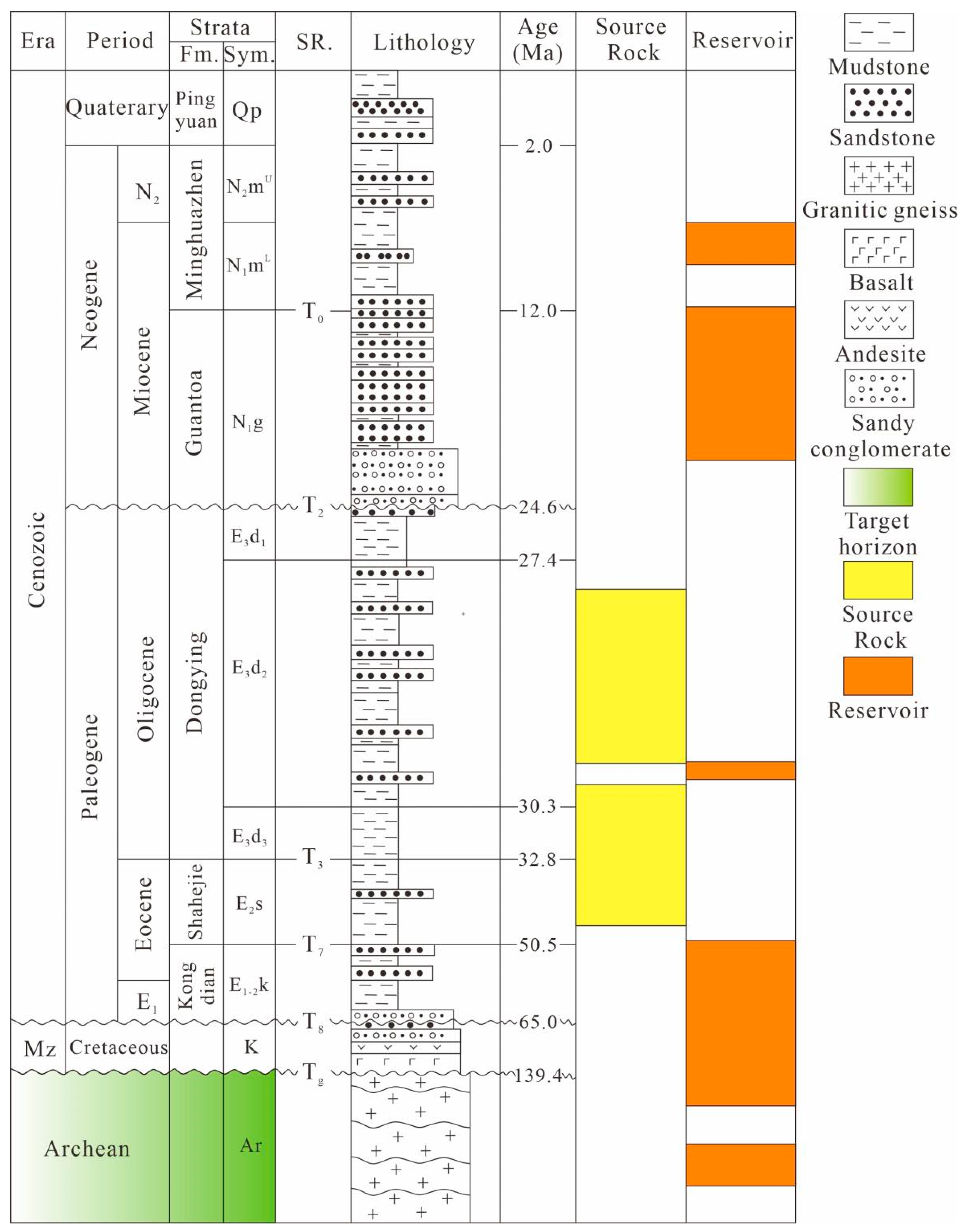
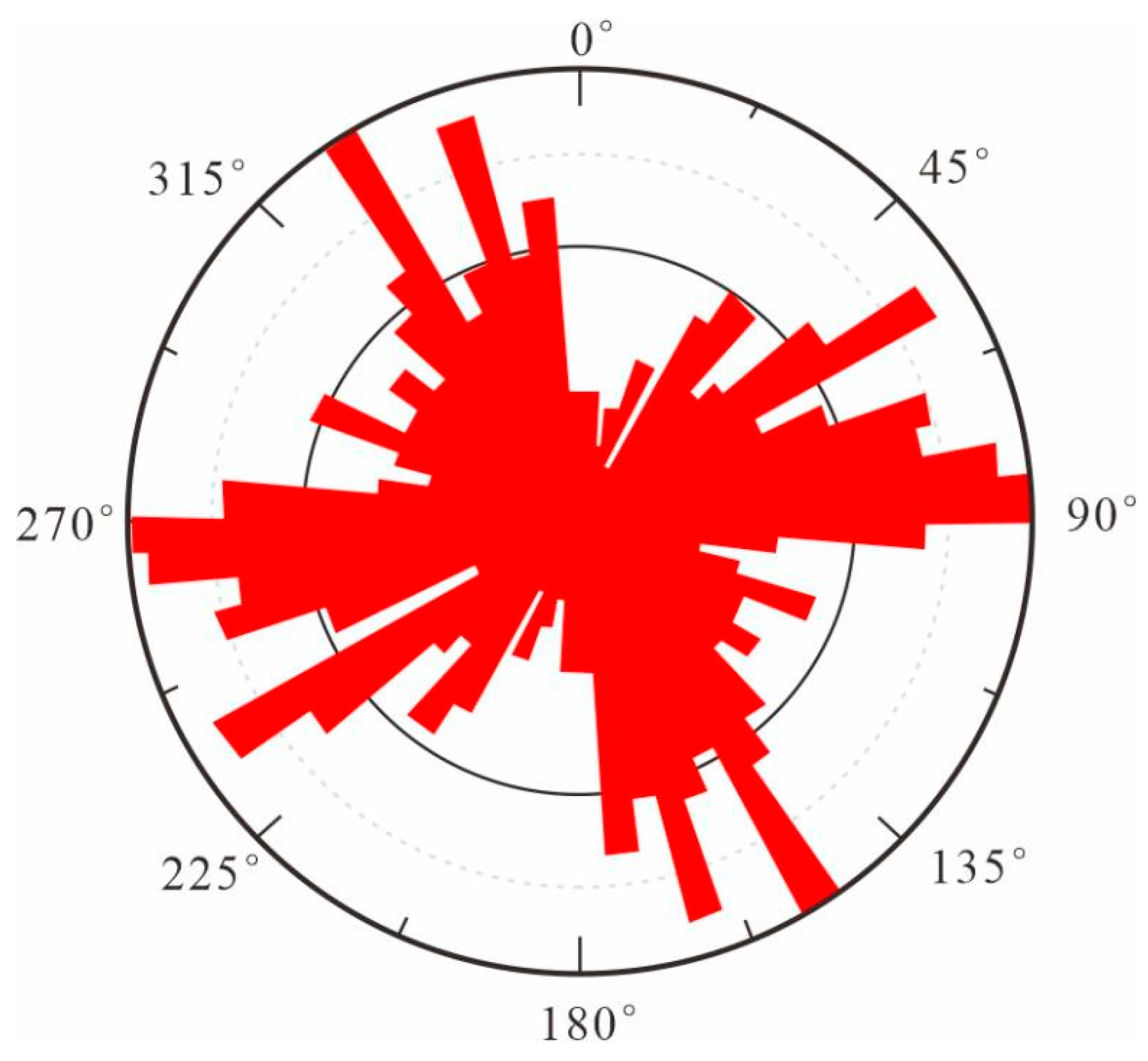
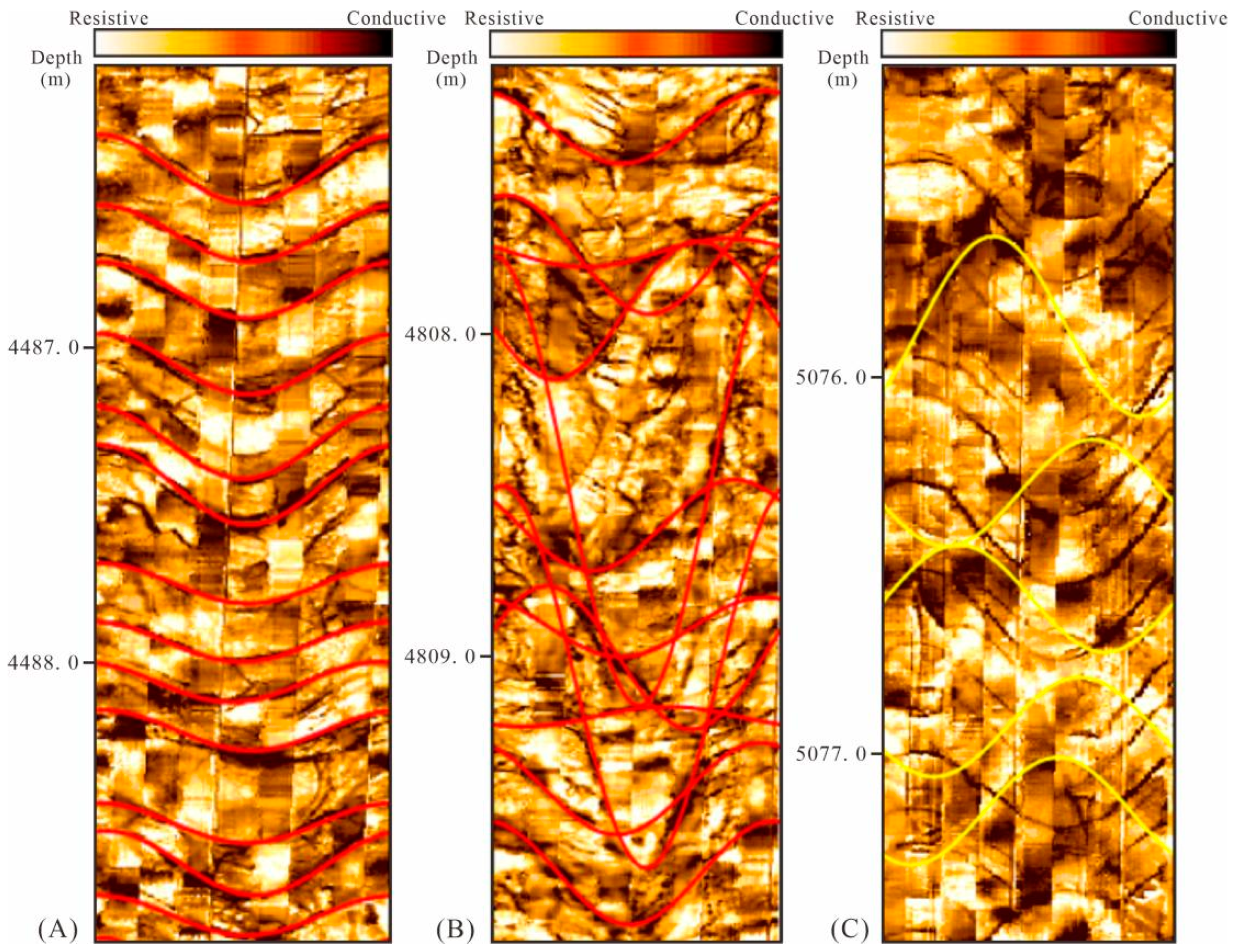
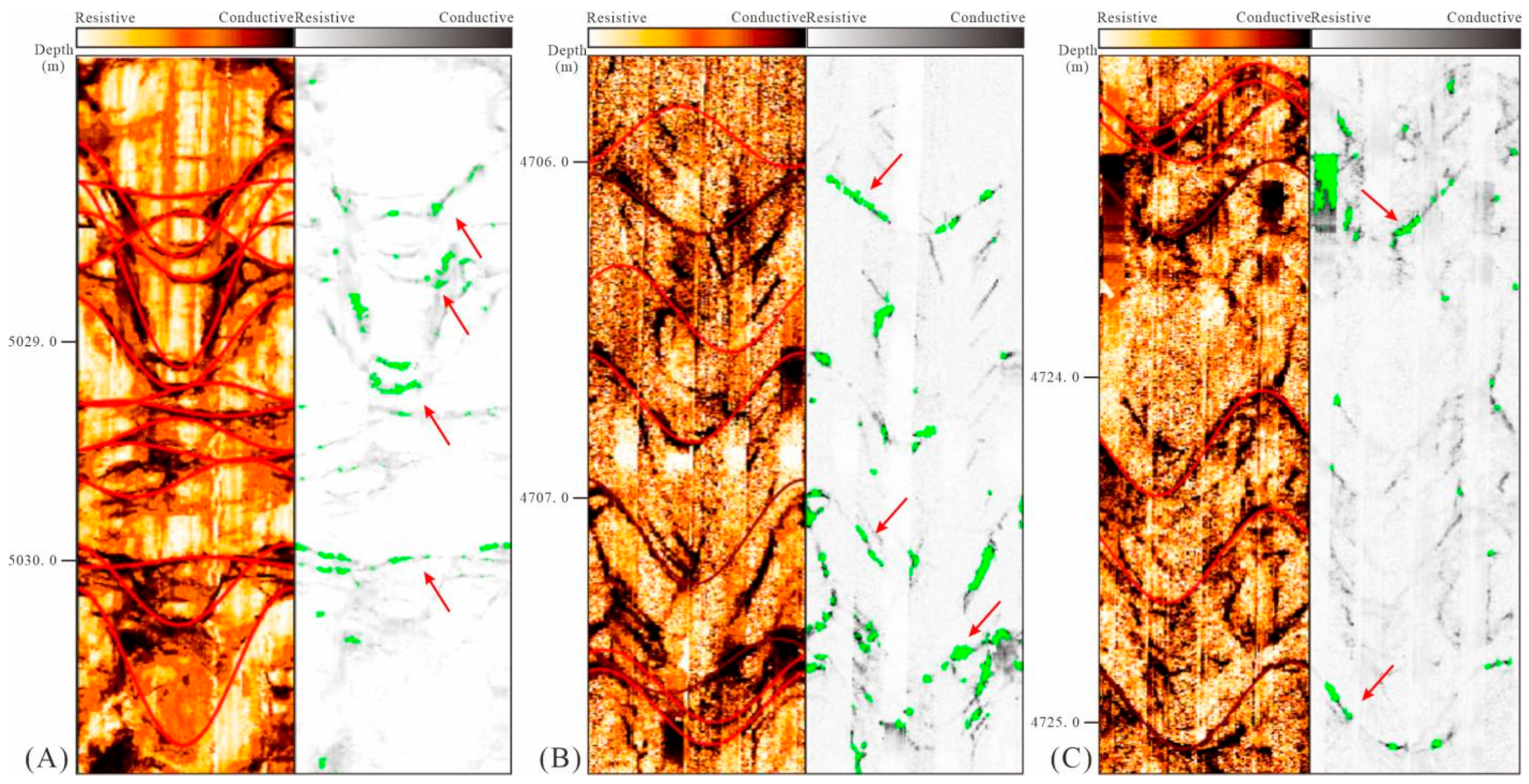
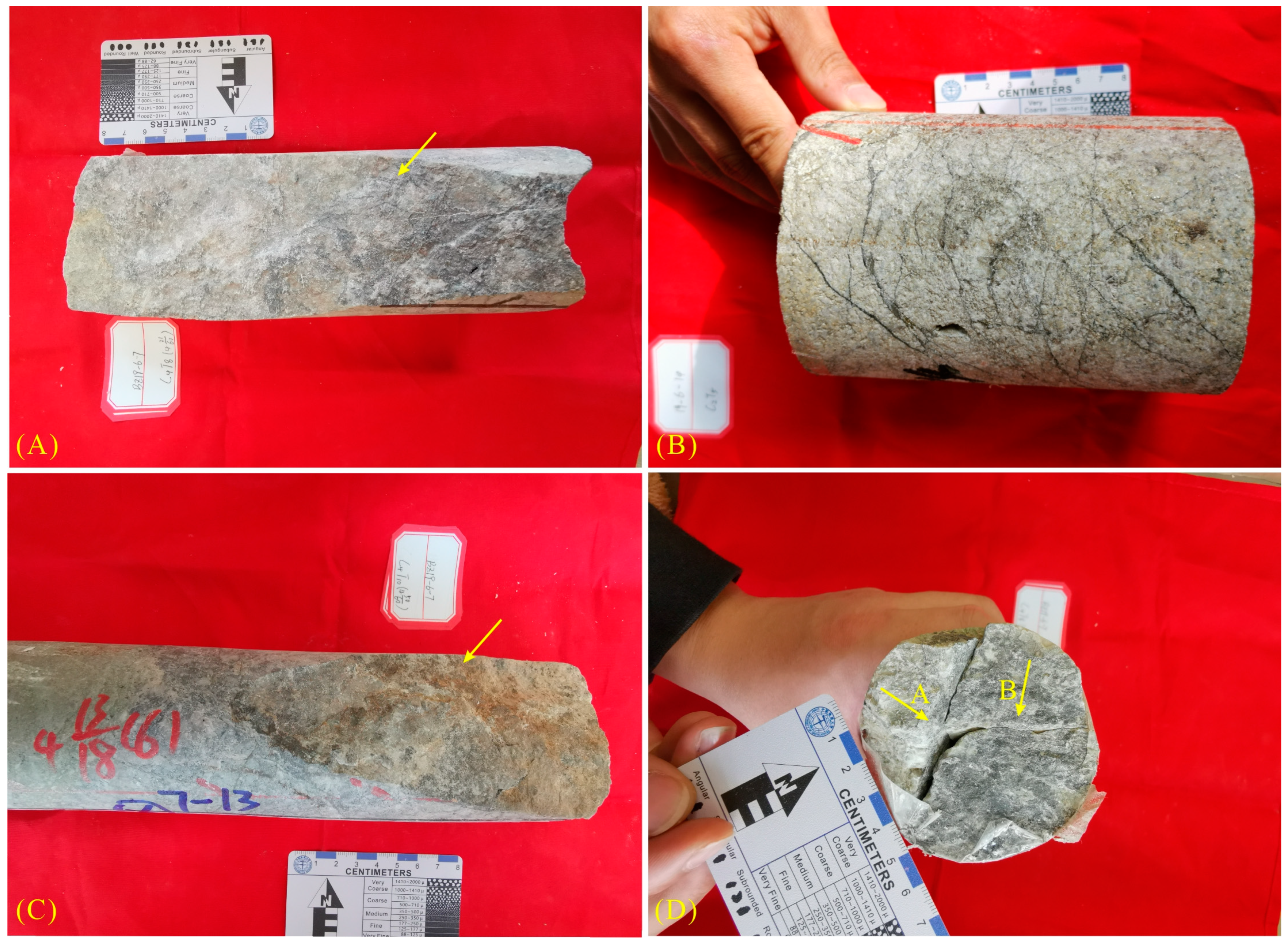



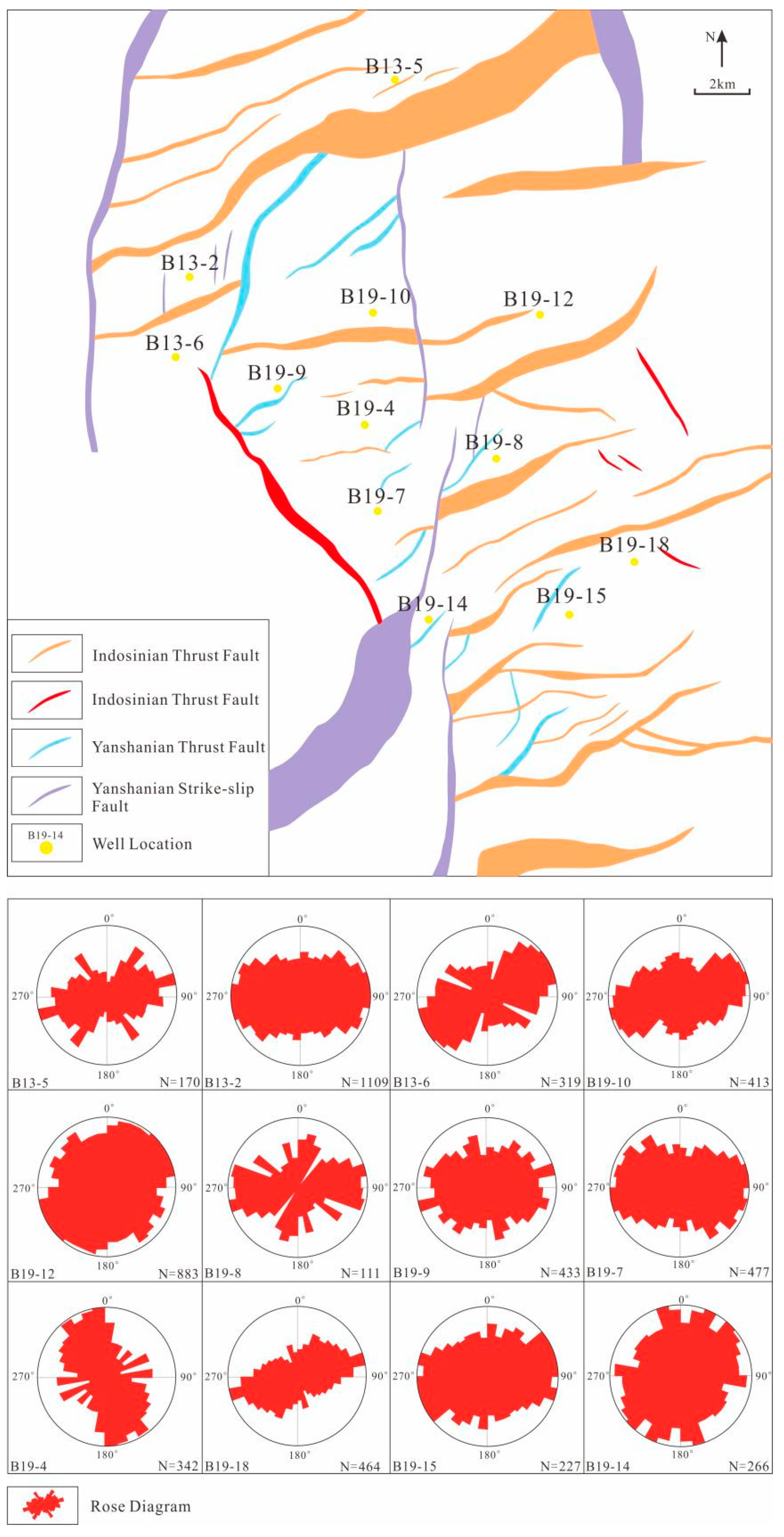


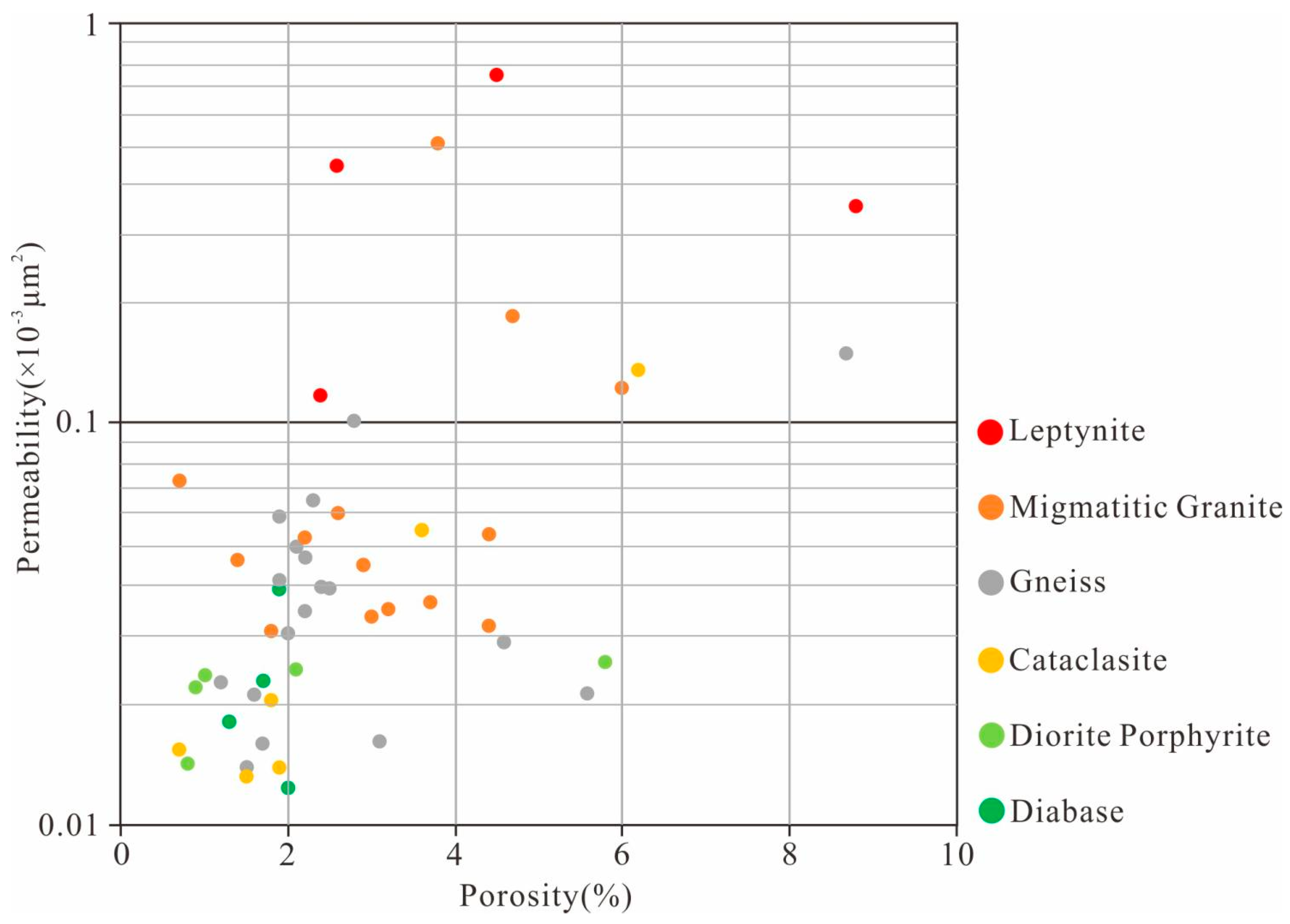
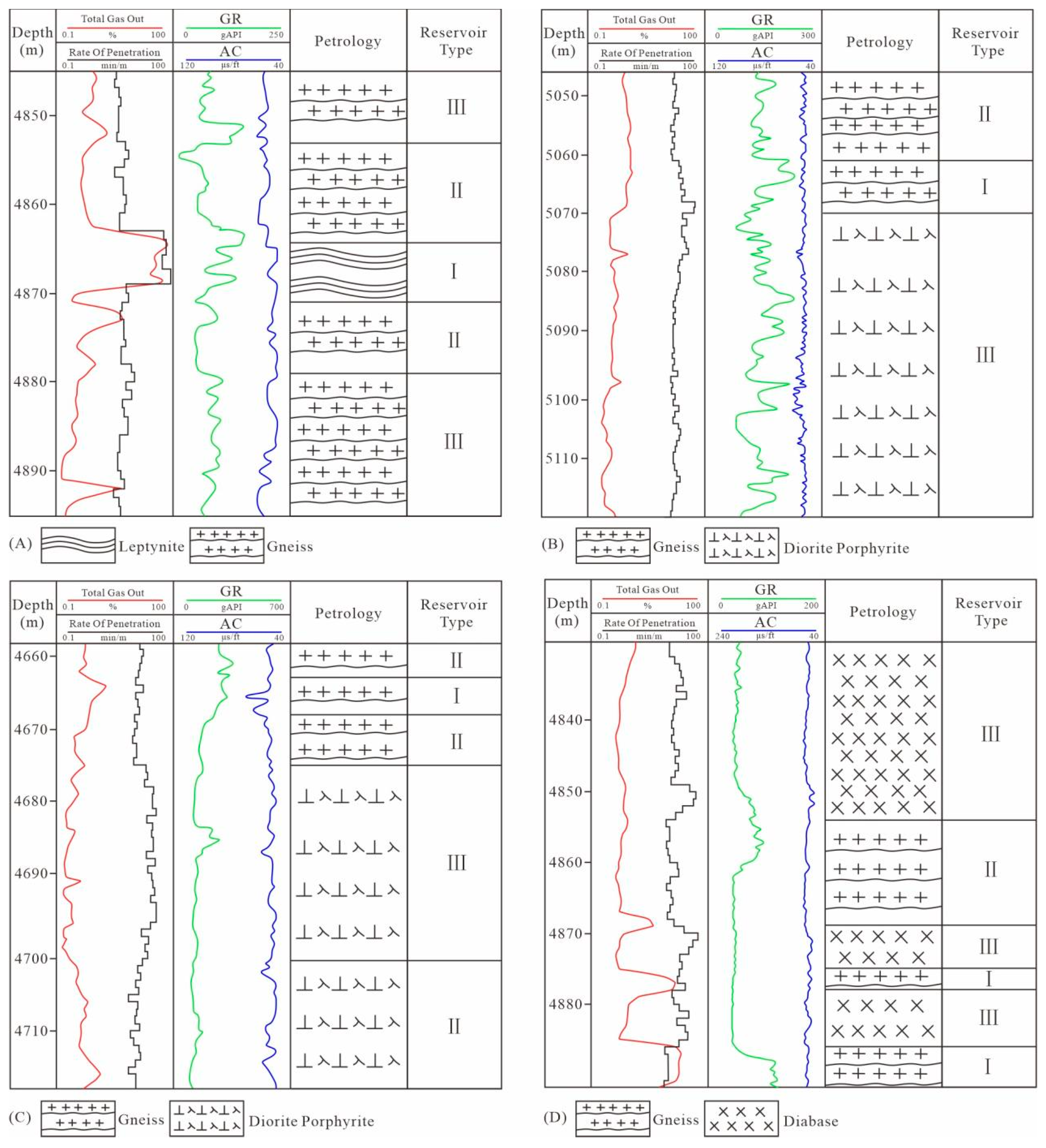
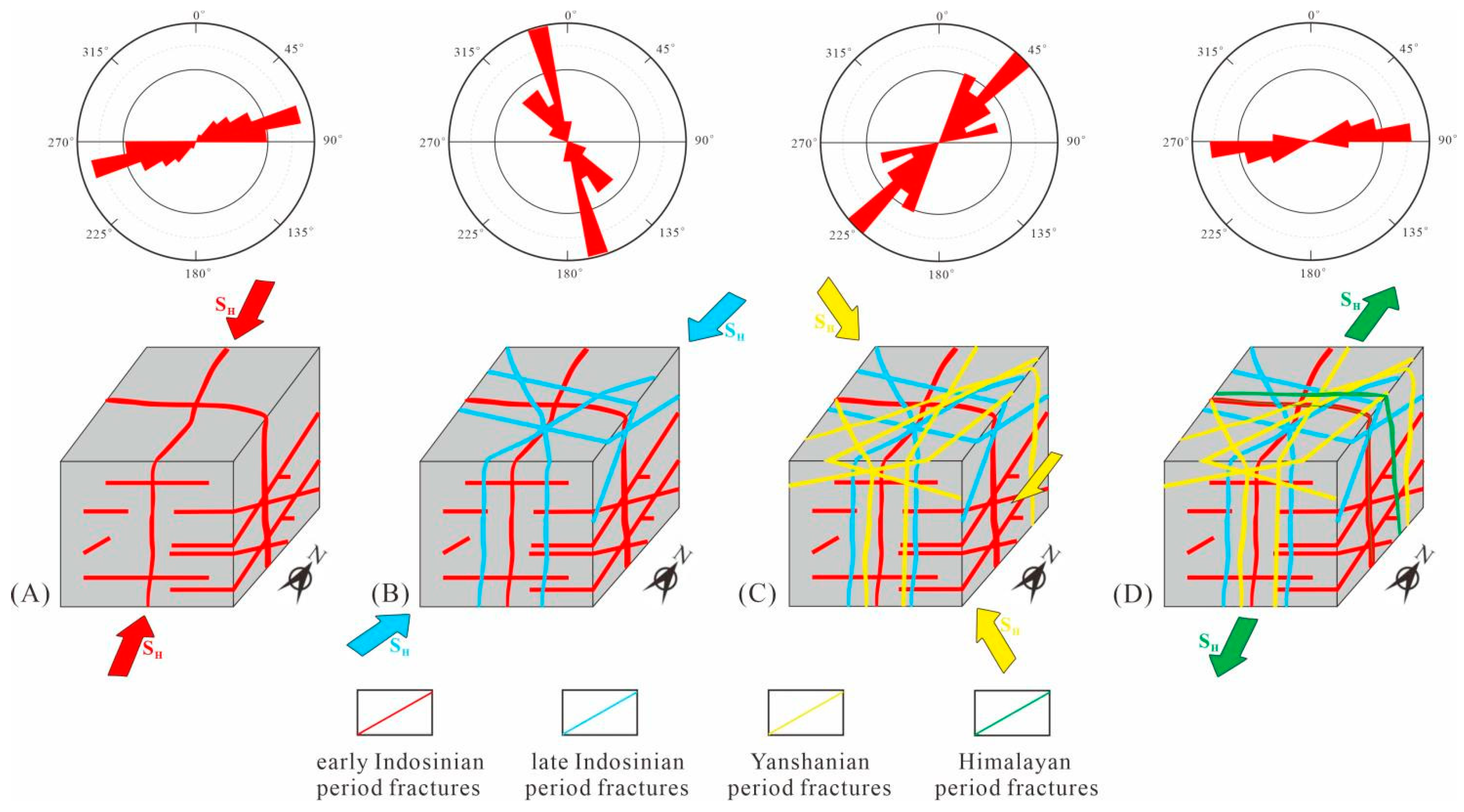

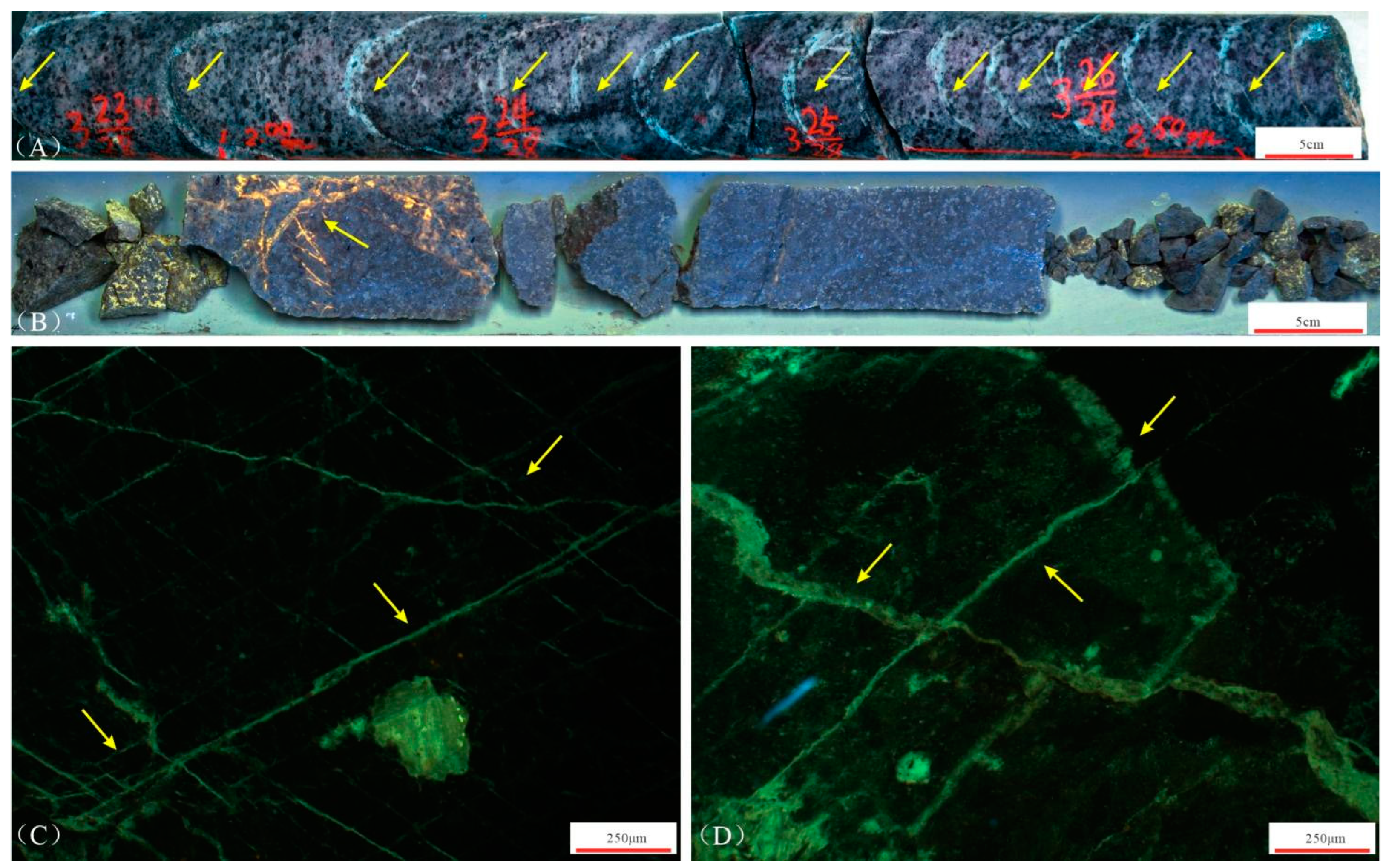
| Petrology | Quartz (wt.%) | Alkaline Feldspar (wt.%) | Plagioclase (wt.%) | Biotite (wt.%) | Amphibole (wt.%) | Pyroxene (wt.%) | Others (wt.%) |
|---|---|---|---|---|---|---|---|
| Leptynite | 49.6 | 22.3 | 21.5 | 0.9 | 1.2 | 0 | 4.5 |
| Migmatitic Granite | 31.3 | 28.3 | 30.5 | 4.3 | 3.8 | 0 | 1.8 |
| Gneiss | 9.3 | 39.6 | 31.8 | 7.9 | 8.3 | 0 | 3.1 |
| Cataclasite | 11.3 | 32.2 | 34.5 | 9.3 | 9.5 | 0 | 3.2 |
| Diorite-Porphyrite | 8.1 | 20.3 | 45.1 | 10.1 | 14.3 | 0 | 2.1 |
| Diabase | 7.5 | 19.5 | 32.3 | 2.3 | 0.8 | 21.2 | 16.4 |
| Petrology | Number of Samples | Porosity (%) | Permeability (×10−3 μm2) | ||||
|---|---|---|---|---|---|---|---|
| Minimum | Maximum | Average | Minimum | Maximum | Average | ||
| Leptynite | 4 | 2.4 | 8.8 | 4.6 | 0.164 | 0.881 | 0.578 |
| Migmatitic Granite | 14 | 0.7 | 6.1 | 3.2 | 0.053 | 0.728 | 0.142 |
| Gneiss | 18 | 1.2 | 8.7 | 2.8 | 0.022 | 0.259 | 0.068 |
| Cataclasite | 6 | 0.7 | 6.2 | 2.6 | 0.021 | 0.221 | 0.067 |
| Diorite-Porphyrite | 5 | 0.8 | 5.8 | 2.1 | 0.024 | 0.046 | 0.041 |
| Diabase | 4 | 1.3 | 2.0 | 1.7 | 0.019 | 0.063 | 0.039 |
| Well | Fracture Density of Strong Weathering Fracture Zone (m−1) | Fracture Density of Weak Weathering Fracture Zone (m−1) | Fracture Density of Basement Zone (m−1) | Fracture Porosity of Strong Weathering Fracture Zone (%) | Fracture Porosity of Weak Weathering Fracture Zone (%) | Fracture Porosity of Basement Zone (%) |
|---|---|---|---|---|---|---|
| B19-2 | 0.52 | 0.45 | 0.39 | 4.0 | 3.8 | 4.2 |
| B19-7 | 1.21 | 1.13 | 1.02 | 3.2 | 2.8 | 2.7 |
| B19-10 | 0.91 | 0.62 | 0.45 | 4.3 | 3.8 | 3.4 |
| B19-11 | 0.28 | 0.11 | 0.04 | 3.2 | 3.1 | 3.6 |
| B19-12 | 1.57 | 1.23 | 1.16 | 3.5 | 2.9 | 2.6 |
| B19-14 | 2.01 | 1.63 | 0.75 | 5.8 | 5.4 | 5.0 |
| B19-15 | 0.74 | 0.52 | 0.41 | 3.0 | 2.7 | 3.3 |
Disclaimer/Publisher’s Note: The statements, opinions and data contained in all publications are solely those of the individual author(s) and contributor(s) and not of MDPI and/or the editor(s). MDPI and/or the editor(s) disclaim responsibility for any injury to people or property resulting from any ideas, methods, instructions or products referred to in the content. |
© 2025 by the authors. Licensee MDPI, Basel, Switzerland. This article is an open access article distributed under the terms and conditions of the Creative Commons Attribution (CC BY) license (https://creativecommons.org/licenses/by/4.0/).
Share and Cite
Zhang, G.; Liu, J.; Zhang, L.; Ahmed, E.; Cheng, Q.; Shi, N.; Luo, Y. Development Characteristics of Natural Fractures in Metamorphic Basement Reservoirs and Their Impacts on Reservoir Performance: A Case Study from the Bozhong Depression, Bohai Sea Area, Eastern China. J. Mar. Sci. Eng. 2025, 13, 816. https://doi.org/10.3390/jmse13040816
Zhang G, Liu J, Zhang L, Ahmed E, Cheng Q, Shi N, Luo Y. Development Characteristics of Natural Fractures in Metamorphic Basement Reservoirs and Their Impacts on Reservoir Performance: A Case Study from the Bozhong Depression, Bohai Sea Area, Eastern China. Journal of Marine Science and Engineering. 2025; 13(4):816. https://doi.org/10.3390/jmse13040816
Chicago/Turabian StyleZhang, Guanjie, Jingshou Liu, Lei Zhang, Elsheikh Ahmed, Qi Cheng, Ning Shi, and Yang Luo. 2025. "Development Characteristics of Natural Fractures in Metamorphic Basement Reservoirs and Their Impacts on Reservoir Performance: A Case Study from the Bozhong Depression, Bohai Sea Area, Eastern China" Journal of Marine Science and Engineering 13, no. 4: 816. https://doi.org/10.3390/jmse13040816
APA StyleZhang, G., Liu, J., Zhang, L., Ahmed, E., Cheng, Q., Shi, N., & Luo, Y. (2025). Development Characteristics of Natural Fractures in Metamorphic Basement Reservoirs and Their Impacts on Reservoir Performance: A Case Study from the Bozhong Depression, Bohai Sea Area, Eastern China. Journal of Marine Science and Engineering, 13(4), 816. https://doi.org/10.3390/jmse13040816







